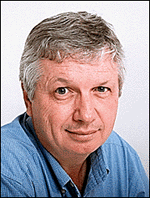


![]()
Talk Story
Political polling today
is increasingly perilousPAT SAIKI has always been ahead of her time. Last Thursday, we discussed her reaction to Linda Lingle's breakthrough victory, and the 1994 Republican gubernatorial candidate raised the issue of polls.
Can "the polls can be so accurate with the younger population using cell phones?" Saiki asked. "You can't reach 'em. They don't have home phones ... you can't poll them.
"Isn't that interesting? A whole segment of the population that has cell phones is never polled. It's usually the younger working people, the ones more likely to vote for Lingle. It's just a theory," Saiki said.
The next day, the lead story on the Wall Street Journal's front page was "Political pollsters rethink methods in wake of election" and "Cell phones and caller ID make it harder to get a good sample of voters."
The national story focused on some real wowsers. Two days before the election, the Minneapolis Star-Tribune poll had Walter Mondale leading Republican Norm Coleman 46 percent to 41, while the St. Paul Pioneer Press poll had them reversed: Mondale 41 percent; Coleman, 47. Coleman won with 50 percent of the vote to Mondale's 47 percent.
In St. Louis the Post-Dispatch poll showed Republican Jim Ryan in a statistical dead heat, 44 percent to 43 percent, in his race for governor against Rod Blagojevich. On Election Day, Blagojevich won with 52 percent to Ryan's 45.
Another high-profile polling mishap occurred in Georgia, where the Atlanta Journal-Constitution's poll showed Gov. Roy Barnes with 51 percent of the vote and challenger Sonny Perdue with a mere 40 percent.
Um, make that governor-elect Perdue -- he won with 52 percent to Barnes' 46.
Locally, Honolulu's two dailies both published polls that showed the race for governor was a dead heat.
The Star-Bulletin poll released on Sunday, Oct. 27, showed Lingle and Hirono tied with 40 percent of the vote each and 18 percent undecided. The sample, which was polled between Oct. 17 and 24, included 600 likely voters and the margin of error was 4 percentage points.
The Advertiser poll released Nov. 1 showed Lingle with 44 percent of the vote, Hirono with 43 percent and 12 percent undecided. The margin of error was 3.6 percentage points, meaning "support for either candidate could be 3.6 points higher or lower," the Advertiser said.
Lingle ended up with 51.56 percent and Hirono 47.01, a 4.55 percentage point difference. Factoring out the undecideds and factoring in the margins of error, both polls were reasonably accurate, if neither informative nor predictive.
Pollsters call random samples of conventional phone numbers. This makes interviewing people under age 40, who have come to rely on cell phones, increasingly difficult, as Pat Saiki pointed out.
What's more, many voters who still use conventional phones screen out survey takers, telemarketers and other nuisances with caller ID.
The Wall Street Journal reported: "Twenty years ago, two-thirds or more of Americans were willing to accept calls from interviewers and linger on the phone for the 20 minutes or so that it takes to conduct the survey. ... Today, that proportion has been cut in half." Non-responses likely have begun to distort results.
It wouldn't hurt Saiki's feelings if the polls went away altogether. "I think the number of polls has been cut back," she said, "which is a relief, let me tell you.
"For a politician, polling affects your ability to raise money. If you're ahead you can raise more money than if you're behind. If it's not accurate, polling distorts the outcome of the election."
Although polls are snapshots of how people say they would vote at a particular instant -- often weeks or months before an election -- not predictions of the outcome, few of us treat them that way.
Especially those with egg on their faces.
John Flanagan is the Star-Bulletin's contributing editor.
He can be reached at: jflanagan@starbulletin.com.